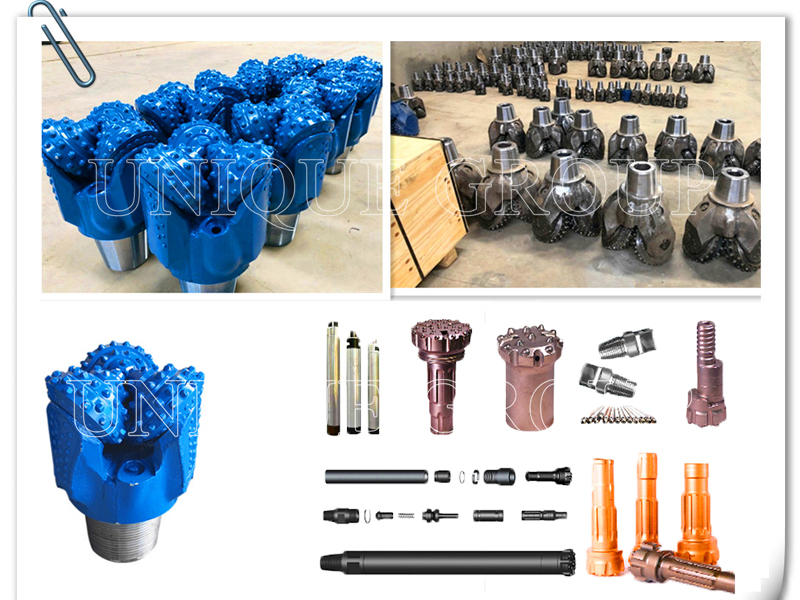The Drill Bit of a Water Well Drilling Rig is So Hard, Will It Be Worn Out When It Encounters Rocks?
Although the drill bit of a water well drilling rig is hard, it may wear out when encountering hard formations such as stones. However, engineers have greatly improved the durability of the drill bit through material optimization, process design and system coordination. This can be understood from three aspects:
The “hardness” of the drill bit: the choice of wear-resistant materials
The wear resistance of the drill bit depends first on the material. For example:
Alloy drill bits will be inlaid with cemented carbide (such as tungsten-cobalt alloy). These alloy particles are extremely hard (equivalent to 3-4 times that of steel) and can cut rocks like “micro blades”. Even local wear can be repaired by repair welding.
Diamond drill bits use artificial diamond composite sheets (PDC). The hardness of diamond is second only to natural diamond. It can break rocks by “scraping” and wears very slowly. It is especially suitable for medium-hard rock formations.
The tooth surface of the roller drill bit will be welded with wear-resistant materials such as tungsten carbide. Through the rotation of multiple toothed rollers to crush the rock, friction wear is converted into rolling wear, further reducing losses.
“Double protection” to reduce wear: cooling and cleaning
When the drill bit is working, the mud circulation system is like a “close bodyguard”:
Cooling: The friction between the drill bit and the rock can generate high temperature (up to 200℃ or more), and the continuous flushing of the mud can take away the heat to prevent the material from softening and becoming brittle due to high temperature.
Cleaning debris: When the mud flows through the bottom of the drill bit at high speed, it will “carry” the broken rock particles to the ground to prevent the rock debris from accumulating around the drill bit to form “abrasives”, just like using a high-pressure water gun to wash away the debris on the surface of sandpaper, reducing additional friction.
Lubrication: The colloidal components in the mud can also form a lubricating film on the surface of the drill bit, reducing direct contact with the rock, similar to applying lubricating oil to gears to reduce wear.
“Smart Design” for Hard Rock: Structural and Mechanical Optimization
When encountering particularly hard rocks (such as granite and basalt), the drill bit also has an ingenious “impact-resistant” design:
Elastic buffering: Some drill bits are equipped with springs or rubber parts inside. When encountering raised hard rocks, they can absorb the impact force through elastic deformation, just like the suspension system of a car reduces bumps, reducing the risk of direct damage to the drill bit.
Compound rock breaking method: Some drill bits use the “rotation + impact” mode (similar to electric hammers), rotating and cutting while impacting rocks at high frequency, breaking large rocks into small pieces and reducing cutting resistance; others are designed as a “stepped” structure, with cutting edges of different diameters breaking rocks in layers to avoid excessive wear on a single layer.
Intelligent monitoring and adjustment: Modern drilling rigs are equipped with sensors to monitor the torque and vibration data of the drill bit in real time. Once abnormal wear is found, the speed will be automatically reduced or the pressure will be adjusted, just like the ABS system of a car automatically adjusts the braking force, to avoid “hard chewing” and causing rapid loss.

“Life Management” of Drill Bits: Regular Maintenance and Scientific Replacement
Even the most wear-resistant drill bits will wear out after long-term use, so regular inspection and maintenance are required:
Observe the wear of the drill bit cutting edge after operation. For example, when the alloy particles are worn more than half and the diamond layer becomes thin and shiny, it is necessary to repair or replace it in time.
For expensive diamond drill bits, you can also repair the worn parts through laser cladding and other technologies to restore most of its performance, just like repairing the rubber on the worn soles to extend the service life.
From an economic point of view, although the initial cost of high-quality drill bits is higher (such as diamond drill bits may cost tens of thousands of yuan), the overall efficiency is better. For example, in hard rock formations, ordinary alloy drill bits may need to be replaced 3-5 times a day, while diamond drill bits can be used continuously for more than 10 days, and the overall cost is lower.
Summary: The “game” between hard drill bits and hard stones is a contest of technology and wisdom
The confrontation between drill bits and rocks is essentially a comprehensive application of material science, fluid mechanics and mechanical design. Modern drill bits can operate efficiently in most strata through the selection of wear-resistant materials, protection of the mud system, and optimization of structural mechanics. When faced with extremely hard geology, it is only necessary to combine the previous geological survey data and select the appropriate drill bit type and construction process to achieve “breaking the hard with cleverness”, ensuring efficiency and controlling wear.
If you need water well drilling rig, please fell free to contact us: phone number:0086 158 90609031
